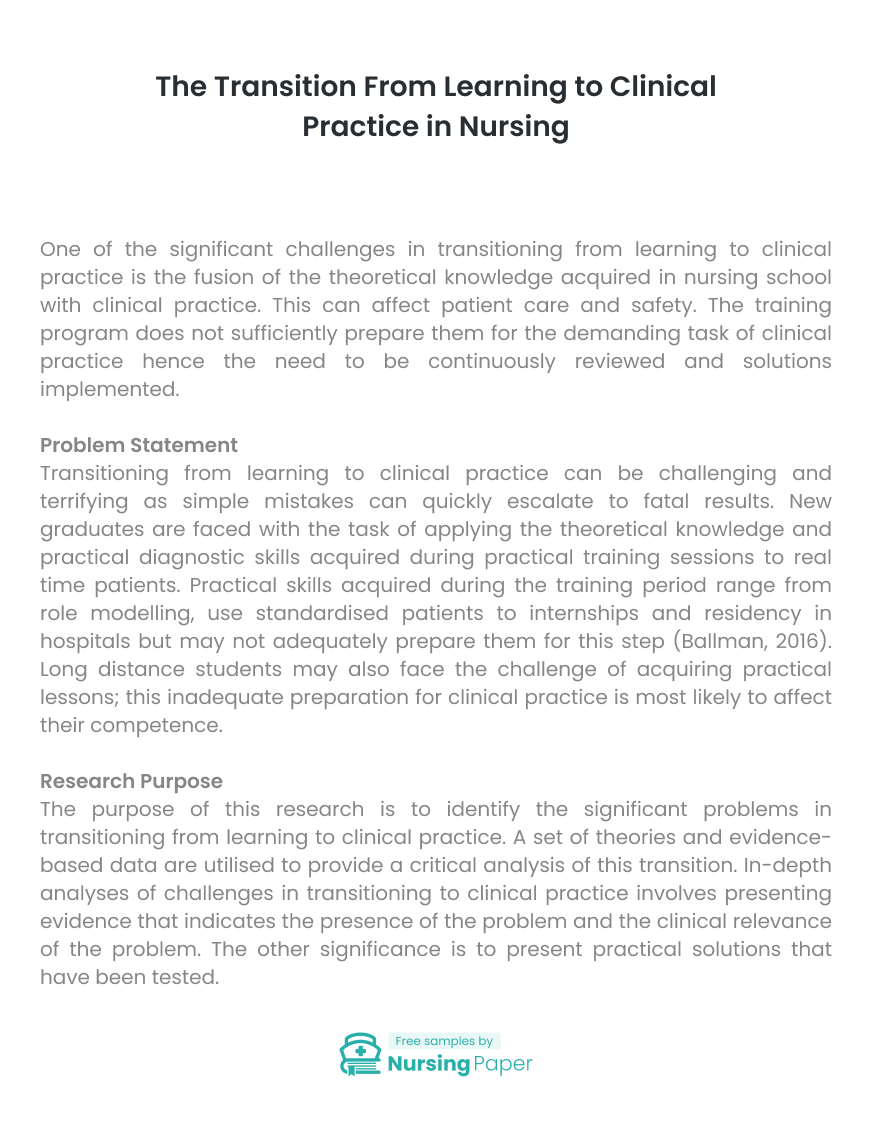
The Transition From Learning to Clinical Practice in Nursing
Introduction
One of the significant challenges in transitioning from learning to clinical practice is the fusion of the theoretical knowledge acquired in nursing school with clinical practice. This can affect patient care and safety. The training program does not sufficiently prepare them for the demanding task of clinical practice hence the need to be continuously reviewed and solutions implemented.
Problem Statement
Transitioning from learning to clinical practice can be challenging and terrifying as simple mistakes can quickly escalate to fatal results. New graduates are faced with the task of applying the theoretical knowledge and practical diagnostic skills acquired during practical training sessions to real time patients. Practical skills acquired during the training period range from role modelling, use standardised patients to internships and residency in hospitals but may not adequately prepare them for this step (Ballman, 2016). Long distance students may also face the challenge of acquiring practical lessons; this inadequate preparation for clinical practice is most likely to affect their competence.


Research Purpose
The purpose of this research is to identify the significant problems in transitioning from learning to clinical practice. A set of theories and evidence-based data are utilised to provide a critical analysis of this transition. In-depth analyses of challenges in transitioning to clinical practice involves presenting evidence that indicates the presence of the problem and the clinical relevance of the problem. The other significance is to present practical solutions that have been tested. An analysis of the practicality of the solutions is vital before implementing the changes. This research, therefore, targets loopholes in the training process that affect transition into clinical practice and to recommend the solutions for streamlining the curricula to enhance practicality.
Research Question
Exposure of recent nurse graduates to unsupervised patient handling is minimal at this stage, and as such, they are prone to mistakes (Wagner, 2018). Medical mistakes involving human life can lead to further complications and misguided diagnosis. The question should be therefore designed to solve part of the problem. In this case, it should include a solution for a smooth transition process; for instance, an efficient fusion of the theoretical training knowledge with clinical practice. The characteristic of the population inpatient care is that they are new to the practice and they possess minimum practical skills in handling real patients. The condition of focus for this group is a fusion of the theoretical knowledge of the training process with the clinical practice.
Conclusion
Based on the problem statement and research purpose, the appropriate research question to ask is if bridging the gap between nurses’ training and clinical practice will improve care quality of care and patient safety. For this population, time spends in the handling of patients should be maximised during the training process to build confidence and enhance diagnostic skills. The alternative is to restructure the curricula to be value based rather than being mostly theoretical. The relevant outcomes of this problem if not solved are a reduced quality of patient care and reduced patient safety.

1. Ballman, K. G. (2016). Broadening the Reach of Standardized Patients in Nurse Practitioner Education to Include the Distance Learner. Nurse Educator, 230-233.
2. Wagner, L. M. (2018). Entrustable professional activities for quality and patient safety. Nursing Outlook, 237-243.



The download will start shortly.

The download will start shortly.
 Subject:
Medicine
Subject:
Medicine  Number of pages: 5
Number of pages: 5  Subject:
Medicine
Subject:
Medicine  Number of pages: 6
Number of pages: 6  Subject:
Nursing
Subject:
Nursing  Number of pages: 7
Number of pages: 7  Subject:
Medicine
Subject:
Medicine  Number of pages: 3
Number of pages: 3  Subject:
Health and Social Care
Subject:
Health and Social Care  Number of pages: 3
Number of pages: 3  Subject:
Medicine
Subject:
Medicine  Number of pages: 9
Number of pages: 9  Subject:
Health and Social Care
Subject:
Health and Social Care  Number of pages: 6
Number of pages: 6  Subject:
Nursing
Subject:
Nursing  Number of pages: 4
Number of pages: 4  Subject:
Health and Social Care
Subject:
Health and Social Care  Number of pages: 4
Number of pages: 4  Subject:
Nursing
Subject:
Nursing  Number of pages: 11
Number of pages: 11  Subject:
Nursing
Subject:
Nursing  Number of pages: 2
Number of pages: 2  Subject:
Nursing
Subject:
Nursing  Number of pages: 3
Number of pages: 3  Subject:
Nursing
Subject:
Nursing  Number of pages: 2
Number of pages: 2  Subject:
Medicine
Subject:
Medicine  Number of pages: 9
Number of pages: 9  Subject:
Health and Social Care
Subject:
Health and Social Care  Number of pages: 10
Number of pages: 10 
